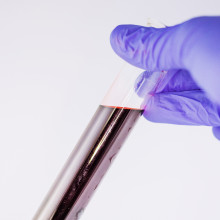What happens throughout the body when you're losing blood, or haemorrhaging? James Fraser let's us know...
In this episode

Naked Body: Dealing with blood loss
James Fraser, University of Cambridge
What happens throughout the body when you're losing blood, or haemorrhaging? James Fraser let's us know...
An adult body contains about 5 litres – ten pints – of blood. The blood circulates, from the heart, to the lungs, to the heart again, then to every cell in the rest of the body, before returning to start the whole cycle. At rest, this full circuit happens once every minute.
When blood flows out of arteries into the tissues, the pressure in the arteries drops (like when air is let out of a balloon), unless the heart is pumping blood into the arteries just as fast. This means that if lots of cells are demanding more blood – for example, if you are using your muscles to run– the heart needs to pump more blood to maintain a constant arterial blood pressure.
It is important to realise that the heart can’t make blood! It can’t pump blood into arteries faster than blood returns to it from the various organs and tissues of the body. If there is less blood in the system, the pressure in the system will tend to drop.
If blood pressure even starts to drop, pressure detectors in the largest arteries signal to the brain via nerves. The brain then starts to ration blood.The blood vessels supplying many of your tissues constrict, limiting flow out of the arteries in an attempt to maintain blood pressure. Adrenaline also narrows veins, helping to squeeze blood back to the heart. You can actually feel this as a horrible lurching, clenching sensation in your guts.
This narrowing of blood vessels diverts blood away from less vital organs, like the skin and the digestive system. But not all blood vessels respond to adrenaline: the signal to reduce blood flow is ignored by your vital organs because they lack the necessary receptors to even detect the signal. This means that blood flow can be maintained in thereally vital organs: the brain, the heart, the lungs… and the gonads. (Remember that, from an evolutionary perspective, testes and ovaries are indeed vital organs!)
You can actually see this diversion of blood from less essential areas because the skin will go pale and cold.
To recover, the body needs to replace the lost blood volume. The most obvious way to do this is by drinking, and indeed loss of blood causes severe thirst – reports from battlefields often mention the sound of injured men pleading for water. At the same time, the kidneys reduce urine output to a trickle.
But what happens if blood loss continues, faster than it can be replaced? Once the body loses more than about 2 of its 5 litres of blood, the body will start to go into what’s called “circulatory shock”. It means that cells are beginning to die from the lack of blood supply. The first organs to be affected are the “less vital” ones, including the kidneys and the gut, while the brain is relatively protected. But as organs start to die, the body’s ability to circulate blood and to divert it towards the vital organs will start to fail. Untreated, shock quickly leads to death.
Fortunately, this degree of blood loss is very uncommon. Our bodies are usually extremely good at limiting bleeding, quite quickly replacing any lost blood, and maintaining blood pressure so that all our cells and organs get all the blood they need, all the time. In fact, a much more common problem in the western world is high blood pressure. But that’s another story!










Comments
Add a comment